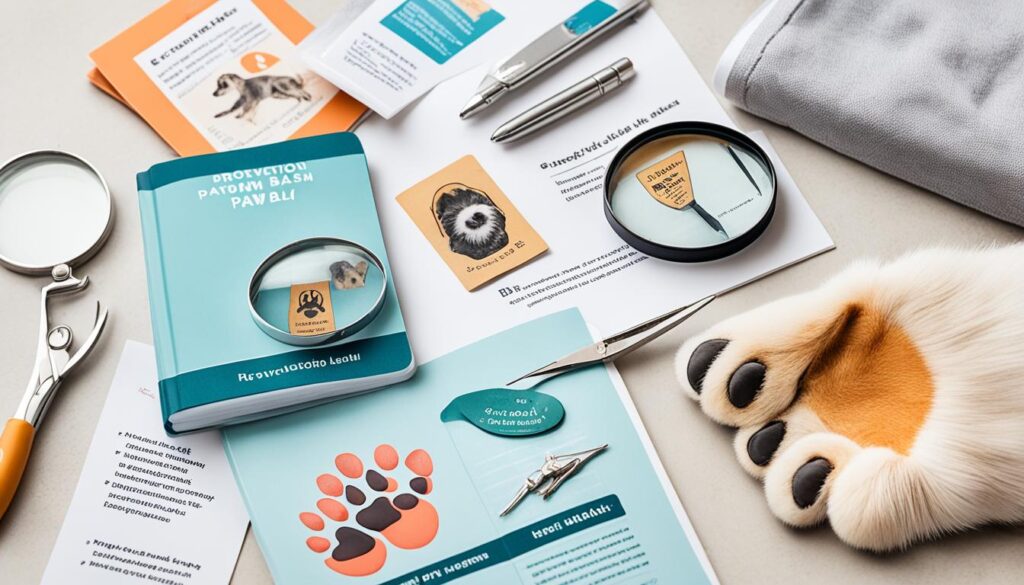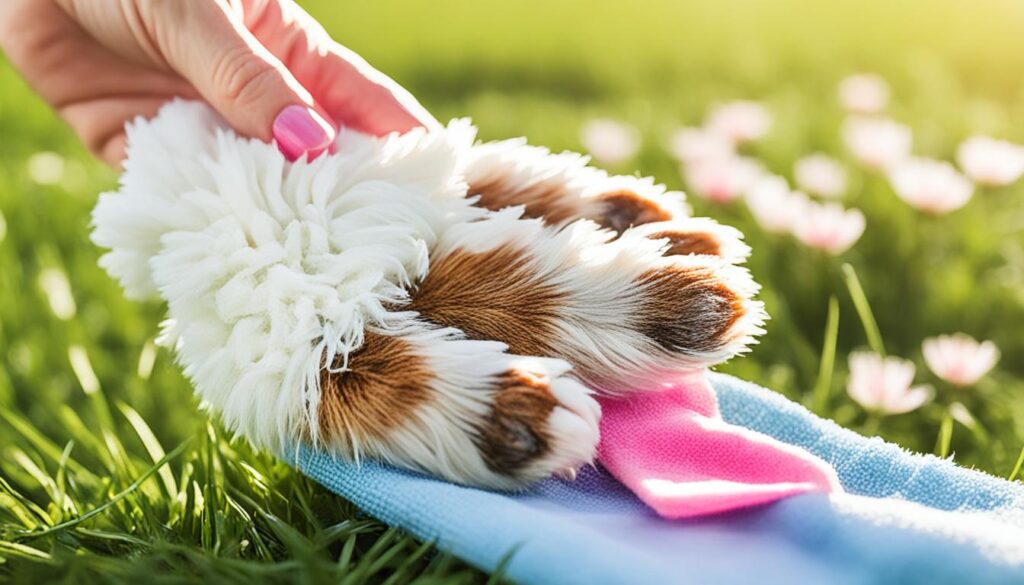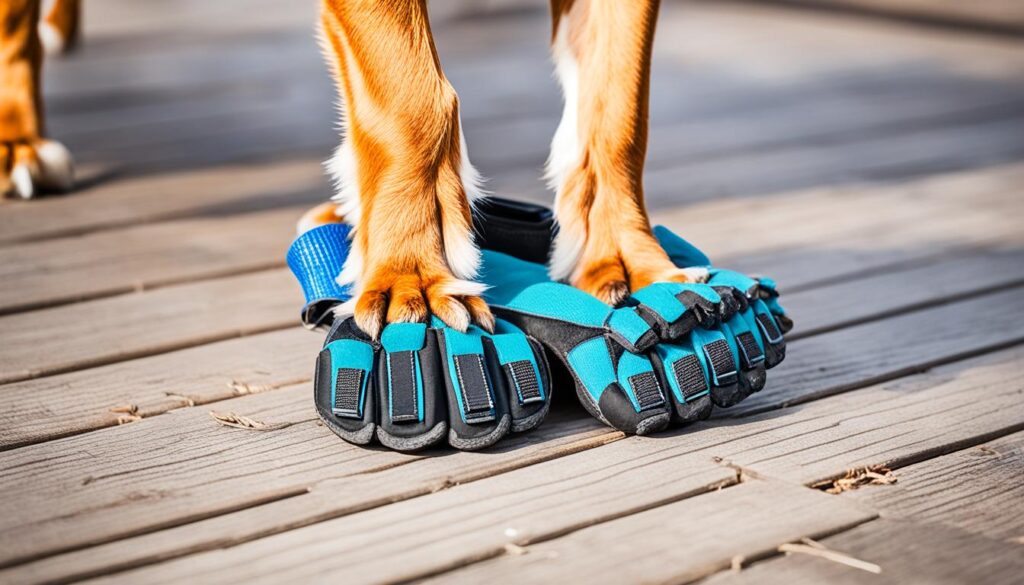Ever thought if you’re doing enough for your dog’s paw health? Many pet owners don’t realize how important paw health is for their dogs. Paws help with balance, traction, and shock absorption, making daily activities easier for your dog. But, they’re often ignored until problems show up.
This guide will show you how to keep your dog’s paws healthy. You’ll learn about preventive steps, regular checks, and maintenance to protect your dog’s paws from common issues. This way, your furry friend can stay happy and comfortable.
Key Takeaways
- Healthy paws provide balance, traction, and shock absorption vital for a dog’s well-being.
- Regular inspections and cleaning are essential for keeping your pet’s paws healthy.
- Proper grooming techniques, including nail trimming, can prevent paw injuries and infections.
- Use paw balms and protective gear to keep paws hydrated and shielded from harsh conditions.
- Consult a veterinarian if any signs of paw problems, such as redness or swelling, arise.
Common Causes of Dog Paw Problems
Dog paws are key for their movement and health. It’s important for pet owners to know how to prevent paw problems. Things like environmental dangers and health issues can cause paw problems. Keeping up with paw care and knowing what to watch for helps prevent issues and keeps your pet healthy.
Cuts and Abrasions
Cuts and scrapes often happen from sharp things, rough ground, or hot surfaces. These can make your dog uncomfortable and might get worse if not treated. Checking your dog’s paws often and using protective boots can help avoid these problems.
Allergies and Irritants
Allergies and irritants can make a dog’s paws inflamed, causing them to lick too much. These can come from things like pollen, grass, or chemicals. Knowing what causes these allergies and avoiding them can help prevent infections.
Bacterial or Fungal Infections
Moisture between the toes can lead to infections. Fungi like yeast and ringworm are common causes. Keeping your dog’s paws dry after walks can stop these infections. Following these care tips can help reduce these problems.
Ingrown Toenails
Long or poorly trimmed nails can cause ingrown toenails, leading to pain and infection. Trimming your dog’s nails regularly is crucial. It helps avoid issues like a changed walk, slipping, and ingrown nails, keeping your dog moving well.
Neurological Issues
Neurological problems can make a dog’s paws curl under, called paw knuckling. This can affect how they move and their paw health. Catching these issues early can lead to better treatment, keeping your pet active and healthy.
Knowing how to prevent common paw problems helps dogs live comfortably and healthily. Regular checks for injuries, swelling, or infections can catch problems early. This makes preventing paw issues a key part of caring for your pet.
How to Prevent Paw Problems in Dogs
Keeping your dog’s paws healthy is key to their happiness and health. There are many ways pet owners can help their dogs’ paws stay in top shape.
Checking your dog’s paws often is a great tip. This lets you spot problems early, like cuts or signs of infection. Watch for signs like limping or swelling, which could mean an infection.
Trimming your dog’s nails every 2 to 4 weeks is also important. This prevents pain and stops issues like ingrown toenails. If you see injuries or deep cuts, see a vet right away.
- Clean and Dry Paws: Clean and dry your dog’s paws after they’ve been outside, especially in wet or dirty conditions. Clean them with warm soapy water, scrub between the pads, rinse well, and dry them off.
- Inspection: Check often for any signs of injury, infection, or swelling.
- Use Protection: Use dog boots or wax to protect their paws from rough surfaces or extreme weather.
Using dog-specific moisturizers is important for paw care. Human moisturizers can be harmful. They help keep your dog’s paws soft and prevent cracking, especially in dry weather.
Trimming the fur around your dog’s paws helps prevent injuries. Long fur can trap dirt, causing irritation. Keeping this area clean is key.
Different breeds have different paw care needs. It’s important to know what your dog needs based on their breed, activity level, and coat type. Some breeds need extra care to keep their paws clean.
| Preventive Measure | Reason |
|---|---|
| Regular Inspection | Identify issues such as cuts and infections early. |
| Proper Nail Maintenance | Prevent ingrown toenails and discomfort. |
| Use of Protective Gear | Safeguard against extreme weather and rough terrain. |
| Cleaning and Drying | Prevent bacterial and fungal infections. |
| Moisturizing | Keep paws soft and free from cracks. |
By following these steps, you can keep your dog’s paws healthy. This is great for their overall health and happiness.
The Anatomy of a Dog’s Paws
Understanding and preventing common dog paw problems starts with knowing their anatomy. A dog’s paws are complex, supporting their movement and balance. They are similar to human hands and feet.
Digital Dog Paw Pads
Digital pads sit under each toe, offering cushioning and shock absorption. They are key for a dog’s comfort and protection when walking or running.
Metacarpal and Metatarsal Pads
The metacarpal pads are in the front paws and the metatarsal pads in the back. These pads spread out the dog’s weight, easing stress on bones and joints.
Dog Claws
Each paw has four claws, with a dewclaw on the front paws. Some dogs have dewclaws on all four paws. Regular trimming keeps them healthy.
Dog Dewclaw
Dewclaws are small, thumb-like claws higher up on a dog’s leg. They help with traction, making climbing or gripping easier.
| Component | Function |
|---|---|
| Claws | Support traction and grip |
| Digital Pads | Provide cushioning and shock absorption |
| Metacarpal Pads | Bear weight and reduce joint stress |
| Metatarsal Pads | Bear weight and offer stability |
| Dewclaw | Assist in climbing and grip |
| Carpal Pad | Aid in quick stops and pivots |
| Webbed Feet | Enhance swimming ability |
Knowing the different paw shapes in dog breeds is key for paw health. “Cat feet” are compact for endurance, while “hare feet” are long for speed. Breeds like the Portuguese Water Dog have “webbed feet” for swimming. Regular care is important for a dog’s paw health.
Healthy Dog Paws vs. Unhealthy Paws
Keeping your dog’s paws healthy is key to their well-being and how well they move. Knowing the difference between healthy and unhealthy paws helps keep your pet’s paws in top shape. It also alerts you to issues that might need a vet’s help.
Characteristics of Healthy Dog Paws
Healthy dog paws have smooth, injury-free pads that feel soft. These pads are full of fats and elastic fibers that help cushion and protect the paws. They also help keep your dog’s body temperature right.
Regular grooming like trimming their nails helps prevent injuries. It also makes sure they can walk easily. Plus, keeping their paws well-groomed and moisturized stops them from cracking and bleeding.
Looking after your dog’s paws means checking them often, especially after they’ve been outside. This helps remove dirt and checks for signs of allergies that could make their paws swell. Using special moisturizers for dogs keeps their paws soft and strong against the elements.
Signs of Unhealthy Dog Paws
Unhealthy dog paws might look dry, have cracks, or have claws that are too long or broken. They could also be red, swollen, not wanting to walk, or licking their paws a lot. These signs could mean allergies, infections, or injuries that need a vet right away.
If your dog smells like corn chips, it might be normal yeast and bacteria. But if it’s too strong, it could mean an infection. Burns and cracks can happen from hot or icy sidewalks. Using dog booties and avoiding extreme temperatures helps keep their paws safe.
Watch for signs like discharge, scabs, bleeding, or a bad smell. These are important clues that something’s wrong and needs attention.
Keep an eye on any sudden changes in your dog’s paws. This can help catch problems early, like infections, allergies, parasites, or even cancer. Regular checks and taking steps to protect them from dangers are key to keeping their paws healthy and happy.
Understanding and Preventing Common Dog Paw Problems: A Guide for Pet Owners
Keeping your dog’s paws healthy is key to their overall well-being. Knowing how to prevent common paw problems can greatly improve your dog’s comfort and movement. Limping can be caused by injuries, arthritis, or infections, which can really lower your dog’s quality of life. This guide will cover how to solve these paw problems, including symptoms, prevention, and treatment.
A good pet owner’s guide to dog paw health means checking paw pads for cuts and trimming nails often. It also means protecting paws from extreme temperatures. For example, long or broken nails can cause pain and make your dog limp. Also, footwear and protective gear like dog shoes can protect paws from hot pavement, rough ground, and ice.
It’s important to know the signs of paw problems. Front leg limping might show as swelling and tenderness, while back legs might be stiff and have less muscle. Spotting these signs early means you can get your dog the care they need fast. This is especially true for serious issues like an ACL tear, which needs quick attention.
At home, you can help with minor paw issues. Rest, ice or heat packs, and supplements like glucosamine and chondroitin can help. Also, a healthy diet and regular exercise are key.
| Dog Paw Problems | Preventive Measures | Solutions |
|---|---|---|
| Cuts and Abrasions | Inspect paws after walks | Clean and bandage |
| Long Toenails | Regular nail trimming | Use dog nail clippers |
| Dry Paw Pads | Moisturize pads | Apply paw balm |
| Infections | Protective footwear | Visit the vet |
Using these strategies helps you take care of your dog’s paws proactively. Regular care and staying alert are crucial for your pet’s comfort and movement. By understanding and preventing common paw problems, you help your dog stay happy and active, with strong paws to explore the world.
Common Dog Paw Injuries and How to Treat Them
Dog paws can face many dangers and injuries. It’s important to know how to treat them. Here are some common issues and how to fix them.
Broken Nails
Broken nails are common in dogs with long nails. Look for limping, crying, and bleeding. To fix a broken nail, cut off the broken part and use styptic powder to stop bleeding. If it keeps bleeding or gets infected, see a vet. Keeping your dog’s nails trimmed helps prevent this.
Burned Paws
Hot surfaces like asphalt can burn your dog’s paws. Signs include redness, limping, and blisters. To treat a burn, cool the paws with cold water and use a soothing ointment. Avoid hot surfaces when walking your dog.
Paw Swelling
Paw swelling can mean an infection, allergic reaction, or injury. You’ll see limping and tenderness too. First, clean the area and use a cold compress. Then, see a vet for the right treatment.
Cracked Dog Paws
Cracks on dog paws come from dry weather, rough surfaces, or too much activity. Look for bleeding, pain, and limping. Clean and apply paw balm to help them heal. Keeping your dog’s paws moisturized is key to preventing cracks.
Self-Chewing of Dog Paws and Nails
Dogs may chew their paws due to allergies, stress, or boredom. This can lead to infections. Signs are redness, swelling, and hair loss. Clean the area, use a pet-safe antiseptic spray, and address the cause. Reducing stress and keeping your dog busy can also help.
Keeping your dog’s paws healthy is crucial. With these tips, you can protect your pet’s paws.
- Check your dog’s paws for injuries often.
- Trim nails regularly to avoid breaks and ingrown nails.
- Avoid hot or rough surfaces to prevent burns and cuts.
- Use paw balms to keep paw pads moisturized and healthy.
| Injury Type | Symptoms | Treatment |
|---|---|---|
| Broken Nails | Limping, crying, bleeding | Trim damaged portion, styptic powder |
| Burned Paws | Redness, limping, blisters | Cool water, soothing ointment |
| Paw Swelling | Limping, tenderness, visible swelling | Cold compress, veterinarian consultation |
| Cracked Dog Paws | Bleeding, pain, limping | Cleaning, applying paw balm |
| Self-Chewing | Redness, swelling, hair loss | Pet-safe antiseptic spray, addressing underlying cause |
Essential Dog Paw Care Tips
Caring for your dog’s paws is key to their health and happiness. Follow these essential tips to keep your pet’s paws in great shape. This ensures they stay healthy and happy.
Regular Inspection and Cleaning
Checking and cleaning your dog’s paws often is crucial for paw health. It lets you spot cuts, abrasions, or irritants early. Use a damp cloth to clean away dirt or debris from their paws, focusing on the areas between the toes.
Trimming Nails and Fur
Trimming your dog’s nails and the fur around their toes is important. Long nails can cause walking problems and injuries. Excessive fur can lead to matting and discomfort. Trim your dog’s nails every 3-4 weeks. For dogs with long fur, trim the hair to avoid nail clipper issues or overgrowth.
Using Protective Gear
Using gear like dog shoes or boots protects your dog’s paws from extreme weather. In hot weather, they prevent burns from hot surfaces. In winter, they keep paws safe from ice, snow, and salt, which can cause paw problems. This is a key tip for keeping your dog’s paws healthy.
Applying Paw Balms
Applying paw balms regularly moisturizes and heals dry or cracked paw pads. Products like Paw Soother Stick or Pawmagik Paw Balm are great for keeping paws soft. Paw wax, such as Musher’s Secret, also works well to protect against pollutants and extreme conditions.
By following these dog paw care tips, you’re helping your pet’s paws stay healthy. A proactive approach to paw care can prevent minor issues from becoming big health problems.
Conclusion
Keeping your dog’s paws healthy is crucial for their overall health. By understanding and preventing common paw problems, you can make a big difference in your dog’s life. Dogs can face many paw issues, from minor cuts to serious infections.
Regular checks and care are key. Trimming nails and fur helps avoid discomfort and infections. Dogs with long hair often get mats between their paw pads. Some breeds, like bulldogs and pugs, are more prone to paw problems due to their paw shape.
Checking your dog’s paws often helps spot issues early. Look for signs like redness, swelling, or a bad smell, which could mean an infection. These signs are important to watch for.
Also, the environment affects paw health. Moist areas can lead to yeast or fungi, while cold weather and chemicals like ice melt can irritate your dog’s paws. Dogs that like to explore might step on sharp things, causing cuts that can get infected.
Being proactive and informed helps keep your dog’s paws healthy. Regular checks and taking care of your dog’s environment are key. This way, your dog will stay happy, healthy, and comfortable.


